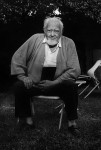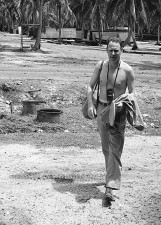
Horace Bristol
American, 1908-1997
Lumbering, Eureka, CA, 1910
gelatin silver print
12 x 10 in.
SBMA, Gift of Karen and Robert Sinsheimer
1991.172a, b


Bristol in the Navy, 1944
COMMENTS
Horace Bristol is one of the original Time/LIFE photographers and the impetus for John Steinbeck’s Pulitzer Prize-winning epic The Grapes of Wrath. His images of WWII are some of the best known and most revealing war photographs taken during the 20th Century.
Bristol’s celebrated career began when he was invited to be one of the original LIFE Magazine photographers. His work was published in conjunction with such photographers as Margaret Bourke-White and Alfred Eisenstaedt. Assignments granted to the young 28-year-old Bristol led to numerous LIFE covers and spreads and included such honors as covering the construction of Coulee Dam, the untouched and fairly unknown islands of Bali, the famed violinist Yehudi Menuhin, and more.
In 1937, Bristol began making his numerous expeditions to California’s Central Valley with renowned FSA photographer Dorothea Lange. Lange shared Bristol’s interest and compassion for the plight of the Central Valley migrant workers and the unemployed in San Francisco during The Great Depression. With a story submission in mind for his employer Time Magazine, Bristol persuaded John Steinbeck to collaborate on the story, who then accompanied Bristol on subsequent trips to Central Valley. There they met, photographed, and interviewed the real migrant workers, Tom Joad, his Ma and Pa, Little Ruthie, Winfield, and others, who would become the namesakes of Steinbeck’s characters in The Grapes of Wrath. [This year happens to be the 100th anniversary of John Steinbeck’s birth. Click “Grapes of Wrath” image to see series.]
After the attack on Pearl Harbor in December, Bristol was recruited by Edward Steichen, the most influential photographer of the 20th Century, to be one of five photographers to document World War II under his U.S. Naval command. Bristol, like a true magazine and newspaper man, captured images of patriotism and heroism with the human interest story as the visual focal point. His most recognized image from this time is of a young PBY Blister Gunner nude at his post after rescuing a fellow officer [click on image].
Bristol’s career led him to Asia following World War II, where he spent 25 years documenting the rapid modernization of Japan, Korea, China, Burma, and Formosa (now Taiwan). He returned to the states with his new bride and two children and lived in Ojai, California, until his death in 1997.
SBMA CURATORIAL LABELS
Featured in SBMA’s Watkins to Weston exhibition (1992) was this work by Horace Bristol. Bristol was among the first Life magazine photojournalists and spent his career chronicling people and architecture, most prominently in California and Japan. During the 1930s, he steadfastly documented the plight of the migrant worker during the Great Depression. He travelled throughout Northern and Central California alongside contemporaries such as Imogen Cunningham and Dorothea Lange. A master printer and originally a self-publisher of his own journal, Bristol’s photographs were often printed for publication. It appears Lumbering, Eureka, CA was originally bound in a book, as indicated along the right edge and with images printed on both the front and back of the paper mount.
At the time this photograph was taken, Bristol was also working on a social documentary picture book in collaboration with John Steinbeck. Though the book was never realized, Bristol’s images of Oklahoma refugees in Tulare Country, CA were a catalyst for Steinbeck’s novel, The Grapes of Wrath (1939).
- Ridley-Tree Gallery 2016
